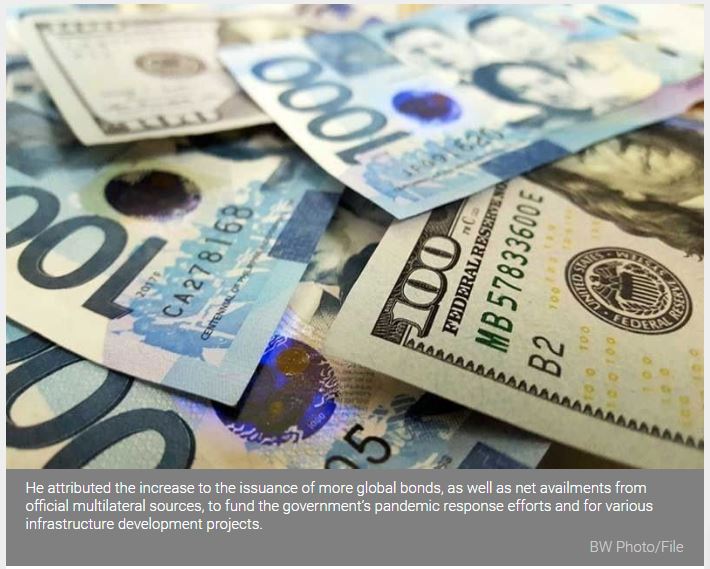Philippines: External debt soars 18% to $98.5 billion in 2020
MANILA, Philippines — The country’s external debt surged by nearly 18 percent to $98.49 billion in 2020 from $83.62 billion in 2019 as the government borrowed more to finance its pandemic response efforts and various infrastructure projects, according to Bangko Sentral ng Pilipinas (BSP) Governor Benjamin Diokno.
He attributed the increase to the issuance of more global bonds, as well as net availments from official multilateral sources, to fund the government’s pandemic response efforts and for various infrastructure development projects.
Likewise, private local banks and non-banks increased their foreign borrowings as they leveraged on a stronger peso against the dollar to diversify their portfolio and maintain a comfortable liquidity buffer.
Diokno said the year-on-year rise in the country’s debt stock was brought about by net availments of $12.6 billion, mainly by the national government, the $1.8 billion increase in non-resident holdings of Philippine debt papers issued offshore and the positive foreign exchange revaluation amounting to $1.5 billion.
The rise in the debt stock, Diokno explained, was partially tempered by prior periods’ adjustments of $1.1 billion.
For the fourth quarter of 2020 alone, Diokno said the country’s external debt increased by 7.1 percent from the third quarter 2020 level of $92 billion, primarily due to net availments of $7.9 billion by both public and private sector borrowers.
The total outstanding debt (EDT), expressed as a percentage of gross domestic product (GDP), stood at 27.2 percent in 2020.
Likewise, Diokno said the debt service ratio that measures the adequacy of the country’s foreign exchange earnings to meet maturing obligations improved to 6.3 percent last year due to lower payments.
Diokno said the country’s gross international reserves (GIR) hit an all-time high of $110.1 billion last year, about 7.8 times the country’s short-term external debt based on original maturity.
“Despite the increase in the external debt, key external debt indicators remained at prudent levels,” he said.
The public sector’s external debt reached $58.1 billion, accounting for 59 percent of the country’s foreign debt. The national government accounted for 89 percent or $51.9 billion of the total, while government-owned and controlled corporations, government financial institutions and the central bank cornered the remaining 11 percent or $6.3 billion.
On the other hand, the external debt of private companies amounted to $40.4 billion for a share of 41 percent.
According to the BSP, major creditor countries include Japan with $15.9 billion, followed by the US with $3.4 billion, United Kingdom with $3.3 billion, and the Netherlands with $3 billion.
Loans in the form of bonds or notes had the largest share with 35.6 percent, followed by borrowings from multilateral lending institutions and bilateral creditors with 34.7 percent, and obligations to foreign banks and other financial institutions with 24.4 percent. The remaining 5.4 percent came mainly from suppliers and exporters.
In terms of currency mix, the country’s debt stock remained largely denominated in dollar with 56.7 percent and Japanese yen with 11.8 percent. The dollar-denominated multi-currency loans from the World Bank and Asian Development Bank accounted for more than 18 percent.
The maturity profile of the country’s external debt remained predominantly medium and long-term in nature with original maturities longer than one year accounting for 85.6 percent, while short-term accounts with maturities of up to one year cornering the 14.4 percent balance.
The national government borrows heavily from foreign and domestic creditors to finance the country’s budget deficit as it spends more than what it actually earns.
Source: https://www.philstar.com/business/2021/03/22/2085990/external-debt-soars-18-985-billion-2020


 English
English




